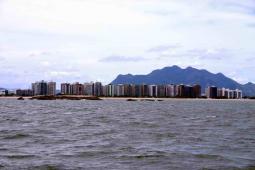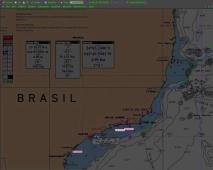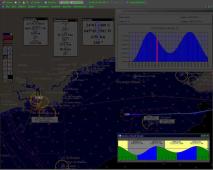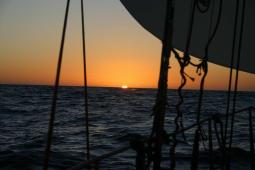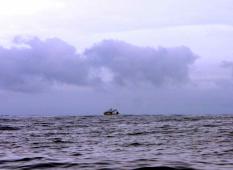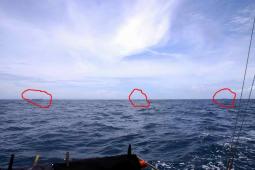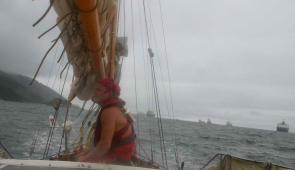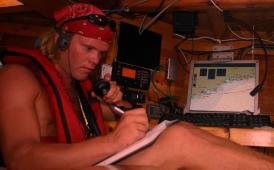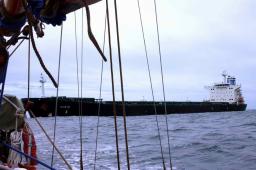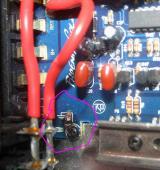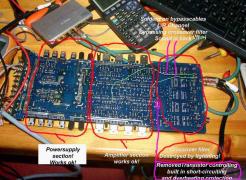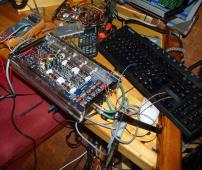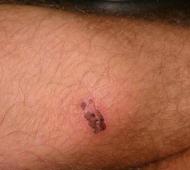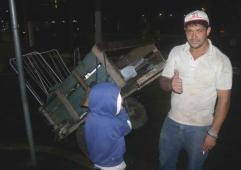Vitoria to Santos
Av Staale
The new bowsprit was assembeled and ready on Tuesday, but because of the coldfront passing by on Monday afternoon, the winds changed to southerlies for the next 24 hrs. I changed the plan and was supposed to leave at Wednesday morning.
I waked up early and prepared the boat for the ocean, went to the supermarket and bought fresh food supplies. Tried a ATM machine to get some cash for diesel. The machine reported "Problema idenficatione carte" when I tried my VISA card. I found another ATM machine and it reported the same. I went to Banco Do Brazil. After waiting 2 hours in the queue I got my cash "the manual way". After some cheap food (Chciken and rice. 1.5 USDollar including a coke.)I headed back to the "Iate Clube".
Since the first three days was free, I didn't have to pay anything to stay in the club. The free stay included: free shore power, free sauna, free shower, free swimmingpool, free internet access and free fresh water. Vitoria was a great place and the local sailors was very helpful and spoke good english. Even one of them spoke swedish! The club was very secured with 24 hrs security and at the gate a computer was connected to a fingerprint identfication machine so to get in you had to press your thumb to get in, on the computer a Picture and the name showed up. Since I was a visitor only for a few days they didn't took any fingerprints of me, and I only had to tell who I was to get inside.
When I was ready to go, the wind had turned into a 15-20 knots right into the marina bassin and I didn't want to try to get out. I would probably make a big hole in one of the other boats with my brand new strong brasilian bowsprit. The wind went down to 10 knots in the evening and with some help from the local sailors we managed to get Rozinante over to the diesel pontoon. A local boat boy helped me across the bay and with some communication problems we managed to tie up on the fueling pontoon.
Another brasillian guy reminded me of some of my friends back home. He didn't came from Vitoria, but stayed here for some weeks while he teached kitesurfing to tourists on the big beach. He stayed in a sailing boat in the Iate club. He had sailed all his life and spoke good english. Once he sailed from Hawaii to Alaska. He learned me lot of things about the brasillian coast. When you get in touch with local sailors they always have some good information about weather conditions, traffic condidtions and other useful information that is not included in the pilot books. This was his way of living: Teaching sailing, windsurfing, kitesurfing, and wave surfing.
Before dark, I got out of the harbour area of Vitroia. Passed by the 15 ships on anchor on the outside of the harbour and tried to run away from a very local thunderstorm. As I got free of the harbour the city of Vitoria was covered in clouds, rain and lightning. After David told me on the radio the hole story about what happened with the english yacht "Tuesday" i'm very afraid of lightning. David onboard "Tuesday" was strucked by an lightning in Salvador de Bahia. He was hit by the lightning and it took some days before he was alright again. Almost every piece of electronics onboard Tuesday was destroyed even the cables and the alternator on the engine. When I spoke to David on the HAM radio I was far out at sea, it was before the bowsprit breakdown and ever since when it's lightning, that is quite often along the Brazilian coast, I thinking about David's words: I would rather die than be hit by a lightning again!
I didn't know if the black clouds included wind gusts so I didn't took the chance to put up any sails before I was well clear of the bad weather. Well clear of any dangerous weather I sat sail in the 15-20 knots wind from the NE. I was on a southerly course inside the 100 meter depth curve and managed to have an average speed of 6.5 knots for the next 48 hrs. This been the best 48 hrs of sailing since Rozinante left Krisitansand, Norway in July 2003. I got a big kick in the stern from the "Corrente do Brazil" that has an average of 1.5-2 knots along the eastern coast of Brazil this time of the year!
The bad part was that I was in the middle of the coastal shipping route and the the fishingboats going from shore and out the 100 meter depth curve to catch fish crossed my course line all the time. At most I counted 16 ships/fishing boats/fishing gear. My sleep these nights was divided in to 25 periods with 10 minuttes sleep for each period. I used a total of 3 Alarm clocks. One on 10 minuttes, second one on 11 minutes and the third one in backup at 15 minuttes. Usually I sleep 15-20 minuttes when there is no ship in sight but the first 48 hrs of this leg there was always "something" in sight! Even if I have had a radar it wouldn't had helped me much. Most of the fishing boats are made of wood and they are so heavly loaded that the engine is bellow waterline and antything that's over waterline is wood and humans and radar signals do not reflect on organic or wooden material. Other sailors with radar I have spoken to says they do not have had any sucessfull contacts on the radars when fishingboats have been in range.
I had a plan to take an offshore route to Santos but the local sailors said it's not that "bad" to sail inshore. An offshore route will take about 2 days more because I would have needed to get around the biggest oil field in Brazil with nearly a hundred oilrigs in operation. The pilot book says you should avoid to sail inside the oilfield and one of my maps even says it is an restricted area for vessels that do not support the oil production.
After passing the oilfield on the inshore and heading out to the sea. I got into a Navy Exercise area. The maps says that it's frequently in use, but I did'nt spot any warships. Finally on my third night at sea I could sleep for 20 minuttes and didn't spot any ship at all during the night. I do not recommend single handed sailing inshore along the Brazillian coast. Take an offshore route!
The last 24 hrs before Santos I had the wind from West and I was heading West so there was no sailing. The wind was less than 10 knots so I maintained a speed of 4 knots with the engine. So far the first 3 days of this leg have been the best sailing since Rozinante left Norway except of all the traffic, but Rozinante needs 15-20 knots to come into the good "mood".
The first part of this text was written one week ago due to some communcations problems it is not published on the site before today Tuesday 2. March.
Since then I have been some days in Sao Paulo the worlds largest city with 17 million inhabitants. The day I came back to Santos I tried to locate a adapter plug to 220 V shore power system used in the marina where rozinante are berthed. In my keeness of finding this plug I ended up in the "favela" (where the poorest people in brazil lives, and all tourist books says stay off/keep off/do not walk alone/do not enter in dark bla. bla. bla.) I wandered thorugh the favela looking at people and all the diffrent things. The middle and upper class of Brasil behave much like europeans. They dress the same, they behave the same way and have the same interesset as any european. There is only one thing that is diffrent between an ordinary european and a brazilian from the middle-upper class. They smile more and are more natural polite. But the favela is diffrent and thats way I am traveling to see something diffrent. Theese people always smile and are very polite and they are also very curious and tries to communicate with you and now that I have been in Brasil for some time I understand some portugese and at least I can explain where I come from, what i am doing here and where i am going, how long i have been sailing and most of the people understand. In the middle-upper class districts of Sao Pualo/Vitoria/Santos there was McDonalds and other western adapted bad things at every corner and that is not what i am looking for. But it was a big experience to see the big City of Sao Paulo.
When I wandered in the favela district looking at the people and the diffrent things that are present in such a district a dog showed signs of interest in me. There are always dogs present in the street inside a favela. Suddenly it attacked and it got a good bite in my leg. I managed to hit in his stomach with my other foot. At this time a was wearing ordinary blue jeans and not shorts. It released and prepared for a new attack. I grabbed a piece of wood and a stone from the street border. I am usualy very afraid for dogs but after some time I have learned that if you do not show any fear they usualy get scared and bear off. I throwed that stone at him and runed after him with the wooden piece in my hand ready to attack him. Some of the locals joined me and we chased the dog until it disappeared between some houses. The local people where very friendly and we made some communcation before I continued wandering through the favela. I was a little scared after the dog episode so I found the fastest way out of the favela area and into the less "poor" area of Santos.
I found my plug and returned to the boat. The same night I wake up in the middle of the night. There was an incomming thunderstorm so I turned of every piece of eletrnoics, turned of all switches and fuses, disconnected the VHF antenna and released the 220V shore power. After a while I noticed that this thunderstorm was very close, and sometimes there was not even a second between the lightning and the thunder. As written in the beginning of this letter I am very, very afraid of lightning. Because of two things: It can kill you, and it can destroy all the electronics in the boat and even burn it out. The result will be: I will be dead or broke or "both". Suddenly there was a real close one it was not a direct hit, but it must have been really close. The whole boat shaked and I could feel the energy in the air. I standed still and tried to find the best spot in the boat with no metal, but could not find any really safe spots so I ended up in my bed with my sleeping bag above my head waiting for this madness to stop. After some time I fell a sleep again.
When I wake up I connected the cables, turned on the correct switches and fuses and tried to turn on some music but no sound came out from the speakers. After some investgation I figured out that there had to be something with my amplifier. The amplifier is connecetd between the computer or cdplayer and the speekers so I can choose if I want to listen to music from the computer or an ordinary car stereo. The amplifier is installed in storeroom behind the seat in the cabin. After removeing a lot of things I got access to the amplifier. The amplifier has an built in protection and the warning light was on. It usualy happens if one of the speaker terminals are short-circuited or it is overheated. It was not overheated and after disconnecting alle the speaker cables the Protection light was still on. I removed the amplifier completely and opened it so I got access to the circuit board and after looking around I noticed at the only point where the circuirt board is grounded to the metal chase was burned off. The metal case for the amplifier also works as a big heatsink for the transistors and is a good electric/heat conductor. Around the screw that made the only ground connection there was burn marks as seen on the picture. In the same storeroom as the amplifier I also have the sentral unit of the HF Transciever and the Marine VHF. Both of them have big metal cases that are properly grounded through 25 mm braid cable to the RF ground system of the boat. The amplifier had only this small circurit and screw between ground and the big metall case of the amplifier. My theroy: When the lightning hit somewhere close by Rozinante it looked for ground and found it in my SSB/VHF/Amplifier the SSB and VHF are very good grounded but when the ground in my amplifier was burned of the lightning found the ground in the circurit board of the amplifier and destroyed some of the electronic components. So far the only result of the lightning is the amplifier. Every other piece of electronics works ok.
Yesterday a friend called me very late in the evening and I told him the story about the amplifier. He have fixed amplifiers and other electronics since he was a little kid. He gave me a three minuttes instruction in how to fix an amplifier while he was drinking beer and doing a lot of other things. I picked up some of it and today I sat down with the amplifier and my multimeter for 6 hours trying to find the fault. The powersupply and amplifier section looked ok. This is usually the things that burns out in a car amplifier. I found a way to disable the built in protection and after another hour I found out that the crossover section where you can adjust treble and bass did not work. So by disableing the built in protection and bypassing the crossover section it made sound to my speakers again. And now it have played for 4 hours and it is still working!!
I acctually had one amplifier in spare because it is very imporant to have music onbard an ocean going sailboat specially if you are sailing alone. But 1: This spare was stored at the wrong place and made a lot of static when I connected it and there is corrosion on the circuirt board and it looks like a mess but with some cleaning it will probably work ok. Someday I have to clean it!
But 2: Since there have been a loop fault between the refridgerator and the refrigeration cooling aggregate, all the refrigerator liquid gas have leaked out I have to find some new gas. This probably happens because of alle movement in the boat and one of the pipecoupling was loose and i lost all the gas so the fridge does not work any more. There is always something to fix! The next days I have a lot of things to fix before my friend comes from norway at the end of the week. We plan to cruise along the coast to Rio de Janeiro for the next 3-4 weeks. This the best cruising grounds in Brazil. There is not much foreign sailors visiting these places because it is a little off the usual around the world cruising routes.

